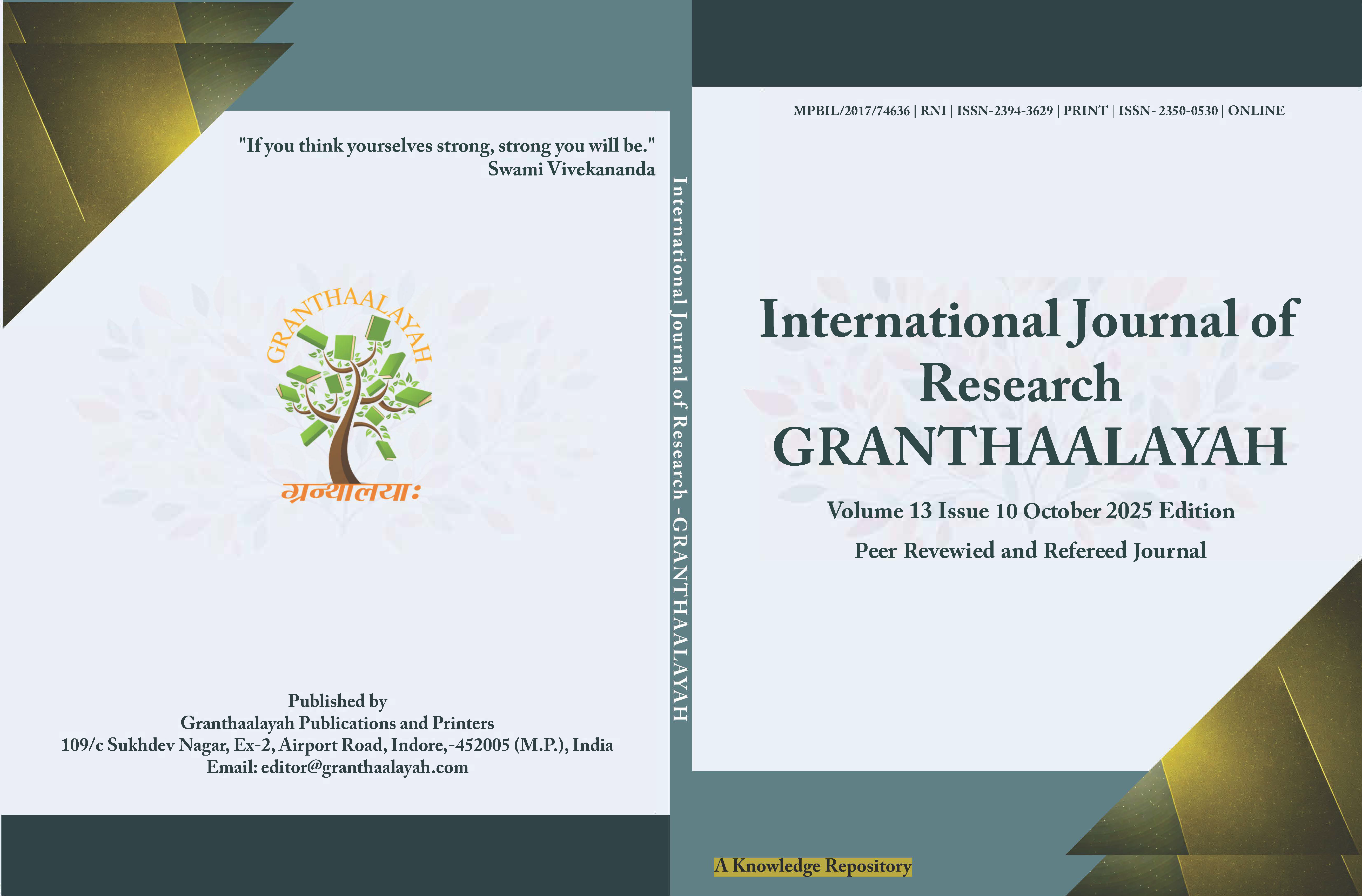EFFECTIVENESS OF ABRASIVE FLOW MACHINING ON ADDITIVELY MANUFACTURED PARTS WITH VARYING CROSS-SECTION GEOMETRIES
DOI:
https://doi.org/10.29121/granthaalayah.v13.i10.2025.6423Keywords:
Additive Manufacturing (Am), Fused Deposition Modelling (Fdm), Surface Roughness, Abrasive Flow Machining (Afm)Abstract [English]
Additive manufacturing has become an important production method nowadays and thanks to the developments in this field, it makes it possible to manufacture complex parts with new practical properties. Although additive manufacturing methods make it possible to produce parts with complex geometries, parts produced with additive manufacturing usually have surfaces with a high degree of roughness. Because of the negative effects on the part's fatigue life and stress concentration caused by this rough surface, it limits its usage in industrial applications. To enhance their surface quality, these parts require post-processing. However, this post-processing enhancement cannot be performed with conventional methods due to the complex geometry of the parts produced with additive manufacturing methods. That is why, the abrasive flow machining (AFM) process which, is an option with better results in the surface finishing of AM parts, is used to improve the surface characteristics. On the other hand, in the abrasive flow machining (AFM) process, the effectiveness of material removal tends to decrease in corner regions, particularly when the flow channel geometry involves sharp-edged profiles such as square or hexagonal shapes. In the study, Poly Lactic Acid (PLA) parts produced with Fused Deposition Modeling (FDM) technique in square, hexagonal and cylindrical sections created in the same volume were produced and subjected to AFM process and surface improvements on the corners and edges were observed. This study aims to demonstrate, through both analytical and experimental approaches, that the efficiency of the AFM process is reduced at the corners of such geometries while overall surface quality is improved. Furthermore, solution-oriented recommendations are proposed based on the analytical evaluations to enhance process performance in these critical regions.
Downloads
References
Boschetto, A., & Bottini, L. (2014). Surface Improvement of Fused Deposition Modeling Parts by Barrel Finishing. Rapid Prototyping Journal, 20(1), 24-31.
Chacón, J. M., Caminero, M. A., García-Plaza, E., & Núñez, P. J. (2017). Additive Manufacturing of PLA Structures using Fused Deposition Modelling: Effect of Process Parameters on Mechanical Properties and their Optimal Selection. Materials & Design, 124, 143-157. https://doi.org/10.1016/j.matdes.2017.03.065 DOI: https://doi.org/10.1016/j.matdes.2017.03.065
Dong, Z., Shen, J., & Chen, G. (2021). Study on Machining Mechanism of High-Viscoelastic Abrasive Flow Machining for Surface Finishing. Journal of Materials Processing Technology, 293, 117055.
Gao, W., Zhang, Y., Ramanujan, D., Ramani, K., Chen, Y., Williams, C. B., Wang, C. C., Shin, Y. C., Zhang, S., & Zavattieri, P. D. (2015). The Status, Challenges, and Future of Additive Manufacturing in Engineering. Computer-Aided Design, 69, 65-89. https://doi.org/10.1016/j.cad.2015.04.001 DOI: https://doi.org/10.1016/j.cad.2015.04.001
Gibson, I., Rosen, D. W., & Stucker, B. (2021). Additive Manufacturing Technologies: 3D Printing, Rapid Prototyping, and Direct Digital Manufacturing. Springer.
Jain, V. K., & Adsul, S. G. (2000). Experimental Investigations into Abrasive Flow Machining (AFM) of Complex Cavities in AISI 316 Stainless Steel Workpieces. International Journal of Machine Tools and Manufacture, 40(7), 1003-1021. https://doi.org/10.1016/S0890-6955(99)00114-5 DOI: https://doi.org/10.1016/S0890-6955(99)00114-5
Jamil, M., Khan, A. M., Sarfraz, S., Zhao, Z., & Ahmed, N. (2021). A Review on Post-Processing Techniques for Additive Manufactured Components. Advances in Mechanical Engineering, 13(4), 1-22.
Kim, D., Park, J., & Lee, J. (2022). Characterization of Deburring by Abrasive Flow Machining using CFD Simulation. Applied Sciences, 12(4), 2048. https://doi.org/10.3390/app12042048 DOI: https://doi.org/10.3390/app12042048
Krolczyk, G. M., Królczyk, J. B., Wojciechowski, S., Maruda, R. W., & Stachowiak, G. W. (2022). Finishing Techniques for Additive Manufactured Components: A Comprehensive Review. Tribology International, 168, 107446.
Kumar, R., Somashekhar, K. P., & Ramachandran, N. (2022). Influence of Process Parameters on Material Removal rate and Surface Roughness in Abrasive Flow Finishing. Materials Today: Proceedings, 62, 1482-1490.
Kumbhar, N. N., & Mulay, A. V. (2018). Post Processing Methods used to Improve Surface Finish of Products Which are Manufactured by Additive Manufacturing Technologies: A Review. Journal of the Institution of Engineers (India): Series C, 99(4), 481-487. https://doi.org/10.1007/s40032-016-0340-z DOI: https://doi.org/10.1007/s40032-016-0340-z
Ngo, T. D., Kashani, A., Imbalzano, G., Nguyen, K. T. Q., & Hui, D. (2018). Additive manufacturing (3D printing): A Review of Materials, Methods, Applications and Challenges. Composites Part B: Engineering, 143, 172-196. https://doi.org/10.1016/j.compositesb.2018.02.012 DOI: https://doi.org/10.1016/j.compositesb.2018.02.012
Parthasarathy, J., Starly, B., & Raman, S. (2011). A Design for the Additive Manufacturing Process for Customized Orthopedic Implants. Journal of Manufacturing Processes, 13(2), 160-170. https://doi.org/10.1016/j.jmapro.2011.01.004 DOI: https://doi.org/10.1016/j.jmapro.2011.01.004
Peng, Z., Gao, J., Li, X., & Sun, Y. (2023). Novel Insights into Abrasive Flow Machining Uniformity for Internal Channels. International Journal of Mechanical Sciences, 249, 108268.
Rhoades, L. J. (1991). Abrasive Flow Machining: A Case Study. Journal of Materials Processing Technology, 28(1-2), 107-116. https://doi.org/10.1016/0924-0136(91)90210-6 DOI: https://doi.org/10.1016/0924-0136(91)90210-6
Rhoades, L. J., & Jain, V. K. (2020). Flow Field and Surface Finishing Uniformity Analysis in Abrasive Flow Machining. Journal of Manufacturing Processes, 56, 1125-1136.
Sharma, V., & Jain, V. K. (2012). Analysis of Media Flow Behavior and Finishing Mechanism in Abrasive Flow Machining (AFM) Process. Wear, 274-275, 289-297.
Somashekhar, K. P., Ramachandran, N., & Kumar, M. (2014). Experimental and CFD Analysis of Abrasive Flow Machining of Complex Cavities. International Journal of Machine Tools and Manufacture, 84, 45-57. https://doi.org/10.1016/j.ijmachtools.2014.04.003 DOI: https://doi.org/10.1016/j.ijmachtools.2014.04.003
Uhlmann, E., & Doits, M. (2020). Modelling the Abrasive flow Machining Process on Advanced Ceramic Materials. Precision Engineering, 66, 161-171.
Ukar, E., Lamikiz, A., del Val, J., & Lopez de Lacalle, L. N. (2013). Laser Polishing of Tool Steel Components Manufactured by Selective Laser Melting. Physics Procedia, 41, 875-880.
Published
How to Cite
Issue
Section
License
Copyright (c) 2025 Omer Eyercioglu, Mehmet Ali Akeloglu

This work is licensed under a Creative Commons Attribution 4.0 International License.
With the licence CC-BY, authors retain the copyright, allowing anyone to download, reuse, re-print, modify, distribute, and/or copy their contribution. The work must be properly attributed to its author.
It is not necessary to ask for further permission from the author or journal board.
This journal provides immediate open access to its content on the principle that making research freely available to the public supports a greater global exchange of knowledge.






























